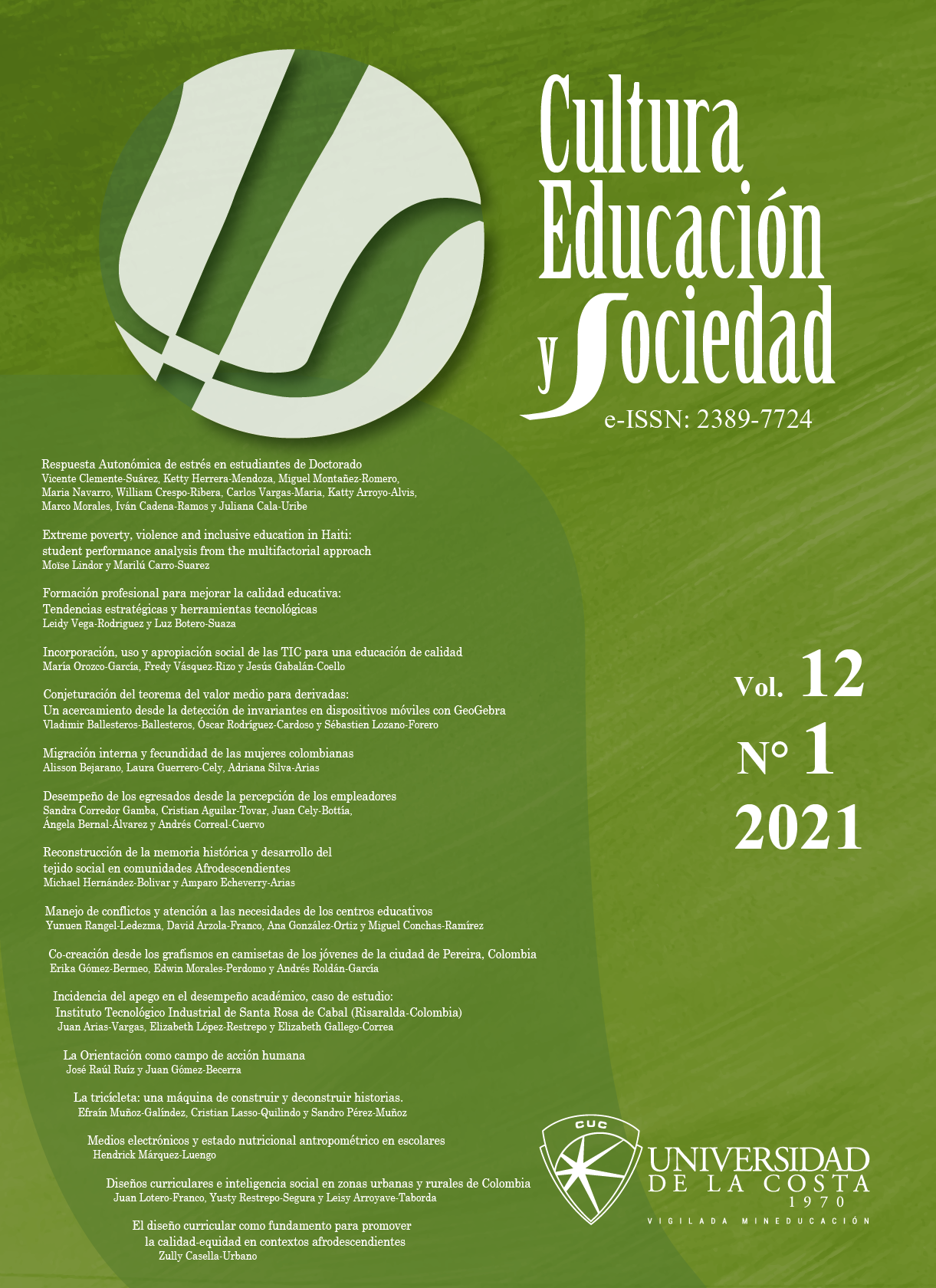Pobreza extrema, violencia y educación inclusiva en Haití: Análisis del desempeño estudiantil desde el enfoque multifactorial
DOI:
https://doi.org/10.17981/cultedusoc.12.1.2021.02Palabras clave:
Violencia, Educativa, Pobreza extrema, Deserción escolar, Percepción del miedoResumen
El objetivo de este trabajo es analizar el impacto de la violencia, el crimen, los secuestros y la pobreza extrema en el rendimiento académico y la salud mental de los alumnos de bachillerato y de licenciatura de las escuelas y facultades públicas ubicadas en Puerto- Príncipe, Haití. Es una investigación cualitativa de tipo deductivo y entrevista semi-estructurada para recolectar los datos y sacar las conclusiones pertinentes. Los resultados evidencian una proporción de estudiantes de licenciatura en situaciones socioeconómicas muy difíciles, y con miedo a ser secuestrados al momento de ir a la escuela, por los actos violentos. Asimismo, los alumnos de bachillerato han expresado su temor a ser violentados, lo que provoca diversos trastornos psicológicos. Se concluyó que la pobreza y los sucesos violentos perjudican la educación inclusiva y continua, el rendimiento escolar, el bienestar colectivo y la tranquilidad de los estudiantes, y la población en general.
Descargas
Citas
Castillero, M. O. (March 8, 2017). What is social violence? In Psychology and mind. [Online]. Available: https://psicologiaymente.com/social/violencia-social#:~:text=Violencia%20social%3A%20%C2%BFqu%C3%A9%20es%3F,o%20por%20la%20propia%20comunidad
Dávila, N. G. (2006). Inductive and deductive reasoning within the research process in experimental and social sciences. Laurus, 12(1), 180–205. Available: https://biblat.unam.mx/es/revista/laurus
Echeburúa, E. (2019). Violence and mental disorders. A complex relationship. Neurology journal, 69(11), 69–472. https://doi.org/10.33588/rn.6911.2019424
ECLAC. (2013). Social protection systems in Latin America and the Caribbean: Haiti. [Online]. Available: https://www.cepal.org/es/publicaciones/4050-sistemas-proteccionsocial-america-latina-caribe-haiti
Educational Trends Information System in Latin America. (2005). Trends in the relationship between education and unemployment in Latin America. [Online]. Available: http://archivo.siteal.iipe.unesco.org/sites/default/files/tendencias_educacion_desempleo.pdf
Espín, J. C., Valladares, A. M., Abad, J. C., Presno, C. & Gener, N. (2008). Violence, a health problem. Cuban Journal of Comprehensive General Medicine, 24(4), 1–6. Available: http://scielo.sld.cu/scielo.php?script=sci_arttext&pid=S0864-21252008000400009
Feijoó, M. & Corbetta, S. (2004). School and poverty: educational challenges in two scenarios in Greater Buenos Aires [Argentina]. [Online]. Buenos Aires: IIPE-UNESCO. Available: https://unesdoc.unesco.org/ark:/48223/pf0000142343
Gamboa, A. (november 27, 2012). Brain drain grows in poor countries. [Online]. Available in: https://aldianews.com/es/articles/politics/crece-fuga-de-cerebros-en-pa%C3%ADsespobres/30058
García, T. (2003). The questionnaire as a research/evaluation tool. [Online]. Available in: http://www.univsantana.com/sociologia/El_Cuestionario.pdf
Garmendia, L. F. (2011). Violence in Latin America. Annals of the Faculty of Medicine, 72(4), 269–276. https://doi.org/10.15381/anales.v72i4.1081
González, E. G., Pardo, M. E. & Izquierdo, J. M. (2017). Violence as a public health problem in Venezuela: some reflections from the perspective of the citizen security professional. Medisan, 21(5), 642–648. Available: http://scielo.sld.cu/pdf/san/v21n5/san20215.pdf
IHSI. (2001). Survey on Living Conditions in Haiti 2001. ECVH, 2001. [Online]. Available: https://catalog.ihsn.org/index.php/catalog/4320
López, N. (2003). What’s new, man? [Document for discussion]. Buenos Aires: Mimeo.
López, J. L. (2001). Scientific Methods and Hypothesis. México, D.F.: Trillas.
López-Roldan, P. & Fachelli, S. (2015). Social research methodology Quantitative. Barcelona: Universitat Autònoma de Barcelona. Available: https://ddd.uab.cat/pub/caplli/2016/163567/metinvsoccua_a2016_cap2-3.pdf
Maya, E. (2014). Research methods and techniques. An agile proposal for presentation scientific work in the areas of architecture, urban planning and related disciplines. Ciudad de México: UNAM. Mexico.
Muñoz, V. (2014). The Human Right to Education. Sinéctica Electronic journal of education, 42(1), 1–10. Available: https://sinectica.iteso.mx/index.php/SINECTICA/article/view/67/59
Narro, J., Martuscelli, J. & Barzana, E. (Coord.) (2012). Ten-year plan to develop the National Education System. [Online]. México, D.F.: UNAM. Available: http://www.planeducativonacional.unam.mx
Ortiz, F. X. (january 29, 2015). The importance of education in Mexico. Practice. [Online]. Available: https://www.gestiopolis.com/la-importancia-de-la-educacion-en-mexico-ensayo/2
Robles, A. L. (2014). Fear in the streets: the main thrill of public criminal insecurity. A criminological and gender study. Journal of the Institute of Legal Sciences of Puebla, 8(34), 81–100. http://dx.doi.org/10.35487/RIUS.V8I34.2014.123
Plazaola-Castaño, J. & Ruíz, I. (2004). Violence against women in the couple and consequences on physical and mental health. Clinical Medicine, 122(12), 461–467. https://doi.org/10.1016/S0025-7753(04)74273-6
Sánchez, C. J. (2016). Insecurity and unemployment. Population and Development Magazine, 29(16), 94–106. Available: https://dialnet.unirioja.es/descarga/articulo/5654297.pdf
Sánchez, R. A. (2015). Student’s T. Uses and abuses. Mexican cadiology magazine, 26(1), México, D.F. Available: https://www.medigraphic.com/cgi-bin/new/resumen.cgi?IDARTICULO=56921
Sarabia, S. (2018). Violence: a public health priority. Journal of Neuro-Psychiatry, 81(1), 1–8. http://dx.doi.org/https://doi.org/10.20453/rnp.v81i1.3267
Schenone, M. & Narodowski, M. (2018). The educability in the educational agenda. A Hybrid Method. [Online]. Available: https://www.researchgate.net/publication/327189371_LA_EDUCABILIDAD_en_la_agenda_educativa_Un_Metodo_hibrido
UN. (2016). Ending poverty. [Online].Available: https://www.un.org/es/sections/issuesdepth/poverty/index.html
UN. (2013). Peace and Security. [Online]. Available: https://www.un.org/es/sections/issues-depth/peace-and-security/index.html
UN. UNDP. (2013). Human Development Report for Latin America 2013-2014. [Online]. Available: https://www.latinamerica.undp.org/content/rblac/en/home/library/human_development/informe-regionalde-desarrollo-humano2013-2014-.html
UNESCO. (october 10, 2018). What you need to know about the right to education. [Online]. Available: https://en.unesco.org/news/what-you-need-know-about-right-education
UNESCO. (2016). Education Policies Recommendations in Latin America based on Terce. [Online]. Santiago de Chile: OREALC/UNESCO. Available: http://www.unesco.org/new/fileadmin/MULTIMEDIA/FIELD/Santiago/pdf/Education-Policies-Recommendations.pdf
UNICEF. (2010). Children in Haiti. Achievements and perspectives six months after the Earthquake. [Online]. Available: https://www.unicef.org/Infancia_en_Haiti-_6_meses_despues.pdf
Vinces, E. (2006). Violence and mental illness. Spanish Journal of Penitentiary Health, 8(3), 95–99. Available: http://www.sanipe.es/OJS/index.php/RESP/article/view/119/279
Vidal, F. (2008). The new accelerators of remoderned violence. In: A. Garcia-Mina (Coord.), New scenarios of violence. Reflections Quotes Social Sciences I (pp. 17–46). Madrid: Universidad Pontificia Comillas de Madrid.
WHO. (2013). Global and regional estimates of violence against women: prevalence and health effects of intimate partner violence and non-partner sexual violence. Ginebra: WHO. Available: http://www.who.int/reproductivehealth/publications/violence/9789241564625/en/
Descargas
Publicado
Cómo citar
Número
Sección
Licencia
Derechos de autor 2020 CULTURA EDUCACIÓN Y SOCIEDAD

Esta obra está bajo una licencia internacional Creative Commons Atribución-NoComercial-SinDerivadas 4.0.
![]()
Creative Commons 2020 CULTURA EDUCACIÓN Y SOCIEDAD
Esta obra está bajo licencia internacional Creative Commons Reconocimiento-NoComercial-SinObrasDerivadas 4.0.
Los artículos publicados son de exclusiva responsabilidad de sus autores y no reflejan necesariamente las opiniones del comité editorial.
La Revista CULTURA EDUCACIÓN Y SOCIEDAD respeta los derechos morales de sus autores, los cuales ceden al comité editorial los derechos patrimoniales del material publicado. A su vez, los autores informan que el presente trabajo es inédito y no ha sido publicado anteriormente.
Todos los artículos están bajo una Licencia Creative Commons Atribución-NoComercial-SinDerivadas 4.0 Internacional.
![]()


 English
English
 Español (España)
Español (España)




_12.53_.27_p_. m_._3.png)





_12.57_.35_p_. m_._3.png)
_12.50_.37_p_. m_._3.png)



